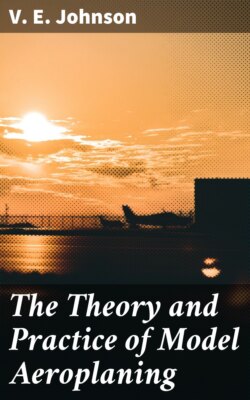Читать книгу The Theory and Practice of Model Aeroplaning - V. E. Johnson - Страница 9
На сайте Литреса книга снята с продажи.
CHAPTER III. THE QUESTION OF BALANCE.
ОглавлениеTable of Contents
§ 1. It is perfectly obvious for successful flight that any model flying machine (in the absence of a pilot) must possess a high degree of automatic stability. The model must be so constructed as to be naturally stable, in the medium through which it is proposed to drive it. The last remark is of the greatest importance, as we shall see.
§ 2. In connexion with this same question of automatic stability, the question must be considered from the theoretical as well as from the practical side, and the labours and researches of such men as Professors Brian and Chatley, F.W. Lanchester, Captain Ferber, Mouillard and others must receive due weight. Their work cannot yet be fully assessed, but already results have been arrived at far more important than are generally supposed.
The following are a few of the results arrived at from theoretical considerations; they cannot be too widely known.
(A) Surfaces concave on the under side are not stable unless some form of balancing device (such as a tail, etc.) is used.
(B) If an aeroplane is in equilibrium and moving uniformly, it is necessary for stability that it shall tend towards a condition of equilibrium.
(C) In the case of "oscillations" it is absolutely necessary for stability that these oscillations shall decrease in amplitude, in other words, be damped out.
(D) In aeroplanes in which the dihedral angle is excessive or the centre of gravity very low down, a dangerous pitching motion is quite likely to be set up. [Analogy in shipbuilding—an increase in the metacentre height while increasing the stability in a statical sense causes the ship to do the same.]
(E) The propeller shaft should pass through the centre of gravity of the machine.
(F) The front planes should be at a greater angle of inclination than the rear ones.
(G) The longitudinal stability of an aeroplane grows much less when the aeroplane commences to rise, a monoplane becoming unstable when the angle of ascent is greater than the inclination of the main aerofoil to the horizon.
(H) Head resistance increases stability.
(I) Three planes are more stable than two. [Elevator—main aerofoil—horizontal rudder behind.]
(J) When an aeroplane is gliding (downwards) stability is greater than in horizontal flight.
(K) A large moment of inertia is inimical (opposed) to stability.
(M) Aeroplanes (naturally) stable up to a certain velocity (speed) may become unstable when moving beyond that speed. [Possible explanation. The motion of the air over the edges of the aerofoil becomes turbulent, and the form of the stream lines suddenly changes. Aeroplane also probably becomes deformed.]
(N) In a balanced glider for stability a separate surface at a negative angle to the line of flight is essential. [Compare F.]
(O) A keel surface should be situated well above and behind the centre of gravity.
(P) An aeroplane is a conservative system, and stability is greatest when the kinetic energy is a maximum. (Illustration, the pendulum.)
§ 3. Referring to A. Models with a plane or flat surface are not unstable, and will fly well without a tail; such a machine is called a simple monoplane.
